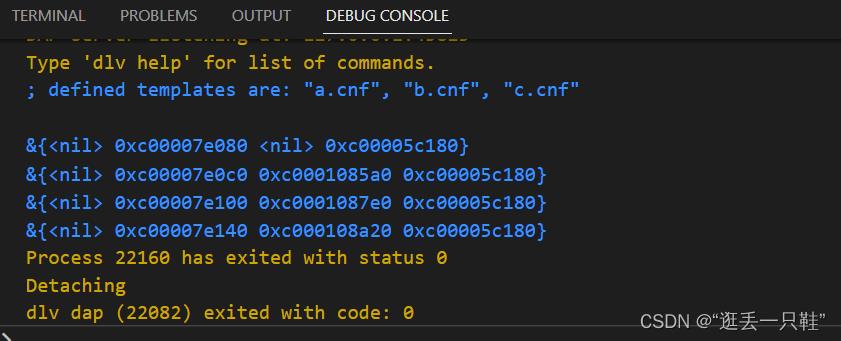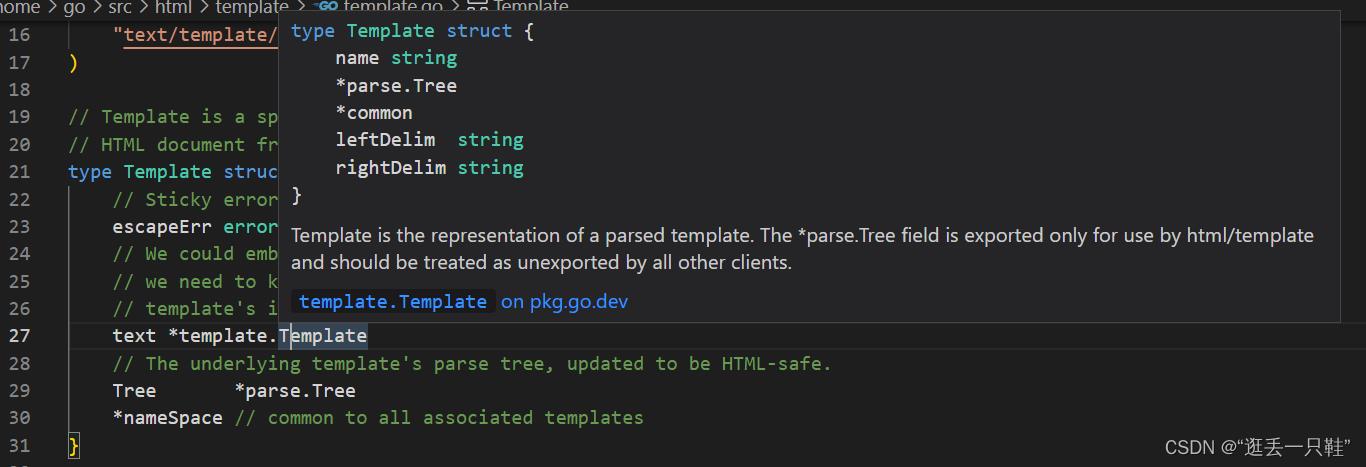html/template 和 text/template区别
Posted “逛丢一只鞋”
tags:
篇首语:本文由小常识网(cha138.com)小编为大家整理,主要介绍了html/template 和 text/template区别相关的知识,希望对你有一定的参考价值。
文章目录
前言
最近在学习go template,跟着一篇文章进行例程的学习,结果发现无论怎么调试,都没有办法复现例程的打印结果
纠结了一天后,求助同事发现了其中的端倪
text/template 是将内容都已text文本格式返回。
html/tempalte针对的是需要返回HTML内容的场景。
在模板渲染过程中会对一些有风险的内容进行转义,以此来防范跨站脚本攻击。
html/template
例程中给出的代码如下
package main
import (
"fmt"
// "text/template"
"html/template"
)
func main()
// ******ParseFiles()方法*****
t1 := template.New("test")
t1, err := t1.ParseFiles("a.cnf", "b.cnf", "c.cnf")
// ******ParseFiles()定义*****
// t1, err := template.ParseFiles("a.cnf", "b.cnf", "c.cnf")
if err != nil
panic(err)
// 先注释下面这行
//t1.Parse("")
fmt.Println(t1.DefinedTemplates())
fmt.Println()
fmt.Println(t1)
fmt.Println(t1.Lookup("a.cnf"))
fmt.Println(t1.Lookup("b.cnf"))
fmt.Println(t1.Lookup("c.cnf"))
理论打印结果应该是:

但是可以看到我们跑程序后打印结果如下:

出现了很大的不一致,这时,我百思不得起解,无论怎么样单步调试,修改输出,都没有办法得到例程输出
最后在同事的提醒下,查看函数的源码,直接F12
首先是Template.New()
// New allocates a new HTML template with the given name.
func New(name string) *Template
ns := &nameSpaceset: make(map[string]*Template)
ns.esc = makeEscaper(ns)
tmpl := &Template
nil,
template.New(name),
nil,
ns,
tmpl.set[name] = tmpl
return tmpl
New返回tmpl,tmpl结构体中我们可以改变的是name,也就是存储我们输入的“test”
这里暂时看不出来端倪,继续看后面的t1.DefinedTemplates(),可以发现也正常,这块输出确实也是对的
func (t *Template) DefinedTemplates() string
return t.text.DefinedTemplates()
那么问题出在哪里呢?
随着调试过程逐渐深入,发现端倪或许在Template中

进入到Template,可以看如下结构体
// Template is a specialized Template from "text/template" that produces a safe
// HTML document fragment.
type Template struct
// Sticky error if escaping fails, or escapeOK if succeeded.
escapeErr error
// We could embed the text/template field, but it's safer not to because
// we need to keep our version of the name space and the underlying
// template's in sync.
text *template.Template
// The underlying template's parse tree, updated to be HTML-safe.
Tree *parse.Tree
*nameSpace // common to all associated templates
无论如何,我们的fmt.Println(t1)打印代码也是按照顺序打印Template结构体,结构体中第一个是erro,第二个是template.Template,第三个是parse.Tree,第四个是*nameSpace
这样也就能解释为什么输出结果是
&<nil> 0xc00007e0c0 0xc0001085a0 0xc00005c180
话说回来,也就是我们的这个结构体压根就没有输出text值,只有erro和内存地址值
跟text有关的我们可以看到在text/template中

text/template
源码看到这里就豁然开朗了
结构体中第一个就是name的字符串
// Template is the representation of a parsed template. The *parse.Tree
// field is exported only for use by html/template and should be treated
// as unexported by all other clients.
type Template struct
name string
*parse.Tree
*common
leftDelim string
rightDelim string
所以,我们只需要修改我们的引用包位置就可以解决和例程输出不一致的问题
package main
import (
"fmt"
"text/template"
// "html/template"
)
func main()
// ******ParseFiles()方法*****
t1 := template.New("test")
t1, err := t1.ParseFiles("a.cnf", "b.cnf", "c.cnf")
// ******ParseFiles()定义*****
// t1, err := template.ParseFiles("a.cnf", "b.cnf", "c.cnf")
if err != nil
panic(err)
// 先注释下面这行
//t1.Parse("")
fmt.Println(t1.DefinedTemplates())
fmt.Println()
fmt.Println(t1)
fmt.Println(t1.Lookup("a.cnf"))
fmt.Println(t1.Lookup("b.cnf"))
fmt.Println(t1.Lookup("c.cnf"))

以上是关于html/template 和 text/template区别的主要内容,如果未能解决你的问题,请参考以下文章